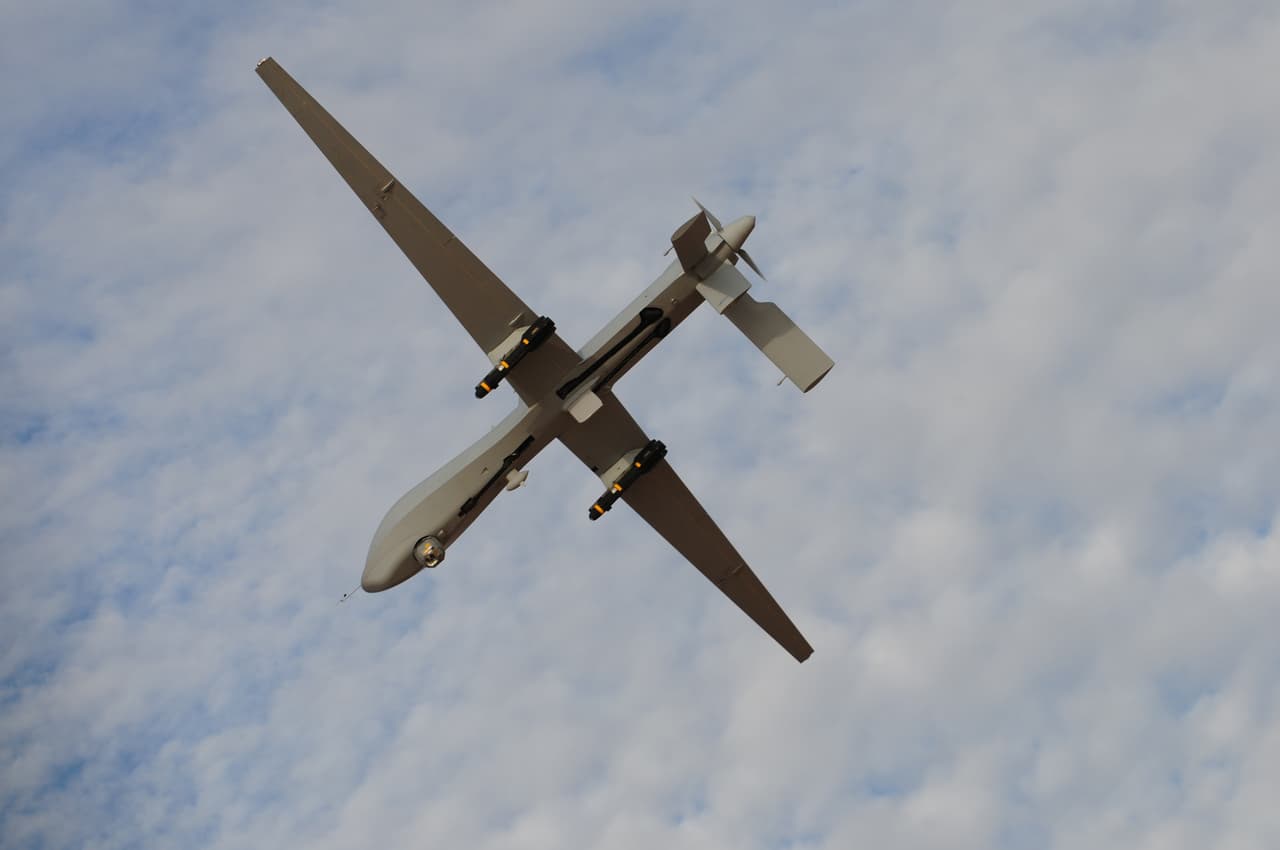
Does must-watch rap video by depressed drone pilots underline recruitment worry for US military?
MQ-1 Predator on Patrol – US Air Force Photo: Lt Col Leslie Pratt
US drone pilots are leaving the military in large numbers after becoming “upset, stressed and depressed” at the long hours, psychological pressures and perception they are little more than “glorified video gamers”, a researcher says in our latest Drone News podcast.
The shortage is so acute the Air Force has just authorised an increase in monthly incentive pay for drone pilots from $650 to $1,500.
Pratap Chatterjee, director of CorpWatch, told the Bureau’s Owen Bennett-Jones that pilots have become disillusioned with the job, and believe they are treated like “second class citizens”.
He said some pilots had grand ambitions of progressing from a seat in front of a screen to become “top gun” fighter pilots, but that instead they eventually become beset with “tremendous psychological problems”.
Until a few years ago, the Air Force relied entirely on conventional pilots to man its drone fleet – people who trained to soar the skies.
The anticlimactic experience of winding up in a workstation in Nevada instead is captured in a rap video on YouTube, made in 2009 apparently by two “once upon a time fighter pilots” calling themselves One G.
The video, entitled “Predator Drivers” and which is discussed in the latest Bureau podcast, shows the two men rapping the words: “You know I used to fly in the sky, flying so high, now all I do is sit and cry.”
(HT ‘Predator: The Secret Origins of the Drone Revolution’, by Richard Whittle)
Although the Air Force now has a special training programme which brings people in to be drone pilots, it is still seen as a career path laden with frustrations, even for those who choose it. Some pilots have been reportedly prevented from attending professional training because military chiefs can not spare them from their seats.
Part of what makes the job unattractive is the sheer overwork brought about by the military’s thirst for intelligence, surveillance and reconnaissance (ISR). Chatterjee, who has been researching the issue, told Drone News that drone pilots are now working “12 hours a day, 6 to 7 days a week”.
A typical drone pilot flies nearly four times as many hours per year as pilots of manned aircraft.
“These pilots are disillusioned, upset, depressed, especially stressed, and so they’re leaving in droves,” Chatterjee told Drone News.
“You’re looking at a screen for 12 hours a day, and you are following individuals, and this starts to play tricks with your mind. Then out of the blue an order comes and says ‘kill that person, press the button and blow them to smithereens’; not only do they do that, they then watch them and their loved ones or their friends be injured, drag themselves to a clinic, bleed to death, they see the funeral, and this is having a tremendous impact on them psychologically.”
In 2012 the Pentagon tasked the Air Force with increasing the daily combat air patrol (CAP) capacity of its drone fleet from 61 to 65. But according to official figures, 240 drone pilots leave the Air Force each year, with only 180 new ones coming through training school to replace them.
In January the Daily Beast obtained an internal memo from a senior Air Force official describing the mismatch between supply and demand of drone pilots as a “perfect storm”.
Already the crew levels for each drone patrol have dropped down below emergency levels, the Daily Beast reported.
Paul Rolfe, a former UK drone operator who was embedded with the US Air Force at Creech Air Force Base in Nevada, explained some of the jarring effects of the job in an interview with Drone News last year.
“You’re hearing the guys on the ground and you’re hearing their stress, so when you finish your shift it’s very odd to then step outside… it’s the middle of the day and you’re in Las Vegas,” said Rolfe.
He contrasted this with being in the field. “You’re there in your body armour, you’re on a base which is full of people who are there at war and doing a job, and you have the mortar alarm going off every now and again, so you’re very clearly somewhere which isn’t nice, but you’re able to decompress with all the other guys that are there at the time.”
A 2013 study on mental health issues among drone pilots which Chatterjee cites in his recent report for Tom Dispatch suggests that such “lack of deployment rhythm and of combat compartmentalization (i.e., a clear demarcation between combat and personal/family life)” may be a source of stress to drone pilots. The study also cites “fatigue and sleep disturbances secondary to shift work; austere geographic locations of military installations supporting RPA (Remotely Piloted Aircraft) missions; social isolation during work… and sedentary behavior” as possible stressors.
Moreover, Chatterjee argues, even though they are physically safe on US soil, drone pilots are drawn in to the trauma of combat in a particularly intense way.
Another measure the Air Force is using to stop the supply shortage is slowing the return of seconded pilots from manned aircraft to their units, according to the Wall Street Journal.
A shortage of regular pilots has also been reported, however, amid surging demand from better-paid commercial airlines.
Follow our drones team Owen Bennett-Jones, Abigail Fielding-Smith and Jack Serle on Twitter.
Sign up for monthly updates from the Bureau’s Covert War project, subscribe to our podcast Drone News, and follow Drone Reads on Twitter to see what our team is reading


